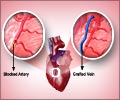CABG (Coronary artery bypass grafting) surgery may be the best treatment option for multivessel heart disease patients, finds a new study.

‘Patients with multivessel disease who received open heart surgery experienced better outcomes and fewer complications compared to those who had a percutaneous coronary intervention.’
Read More..




Dr. Mulukutla and colleagues examined data from two major clinical outcomes registries for heart patients The Society of Thoracic Surgeons (STS) National Database and the American College of Cardiology Foundation National Cardiovascular Data Registry (NCDR). The researchers identified patients with multivessel coronary artery disease who underwent CABG or PCI between 2010 and 2018 at UPMC. Those who met the eligibility criteria were separated into two groups CABG and PCI each including 844 patients. The analyses focused on outcomes for mortality, readmission, and revascularization.Read More..
The researchers found that the estimated one-year mortality for patients in the CABG group was 7.2 percent, as compared to 11.5 percent of the PCI group. The CABG group also experienced a lower risk of hospital readmission (28.1 percent vs. 38.4 percent) and revascularization (1.0 percent vs. 6.7 percent) than the PCI group.
"A major point in the study is the focus on the current era of revascularization with the most currently available stents," said Dr. Mulukutla. "This research is really a modern, 'real-world' experience. While randomized clinical trials are clearly important, real-world analyses also can be very instructive because they provide insights on how we are making clinical decisions. For instance, the last several years have seen a shift toward more PCI over CABG. While there may be valid reasons for this, our data which show CABG outperforming PCI in almost every patient group should push us to further discuss all of the options."
PCI, often referred to as angioplasty, is a nonsurgical procedure that uses a thin, flexible catheter placed into an artery in the groin or arm. A balloon on the end of the catheter is positioned in the narrowed coronary artery and inflated to open up the blockage. A stent is a metal mesh tube that is left behind to help keep the artery from collapsing. Drugs attached to the stent help prevent the body from reacting to the stent and shutting down the artery again.
CABG, the most commonly performed heart operation in the United States, is designed to bypass the blockages in the coronary arteries in order to create a new path for blood flow to the heart. The surgeon removes a healthy blood vessel, usually from the leg, arm, chest, or abdomen, and connects it to the other arteries (usually the aorta) in the heart. This enables blood flow to "bypass" or go around the diseased or blocked portion of the coronary artery.
Advertisement
"Both cardiac surgery and stenting have roles among patients with coronary artery disease," said Dr. Mulukutla.
Advertisement
A heart care team generally includes cardiothoracic surgeons and cardiologists. Other health care providers such as primary care physicians, physician assistants, nurse practitioners, imaging specialists, and anesthesiologists also may be part of the team. This approach leverages the expertise of these advanced practice providers to improve the efficiency and advance the quality of care for patients.
With revascularization, heart team input is often limited because PCI can be completed at the time of a patient's diagnostic procedure. When this happens, the physicians do not have the opportunity to discuss the spectrum of possible treatment options. As a result, the practical and consistent use of the heart team for decision-making in the treatment of patients with complex coronary artery diseases is lacking, Dr. Mulukutla explained.
"We are working to better facilitate a heart team approach and overcome some of the limitations given the current infrastructure of how these decisions are made," said Dr. Mulukutla. "We also are continuing to identify specific patient populations that may benefit from either CABG or PCI so that we can best advocate for our patients."
Source-Eurekalert















